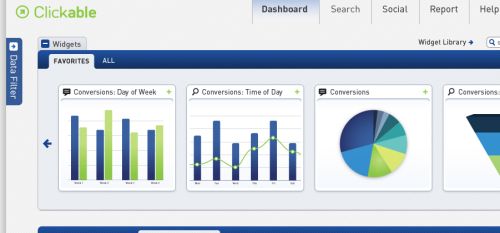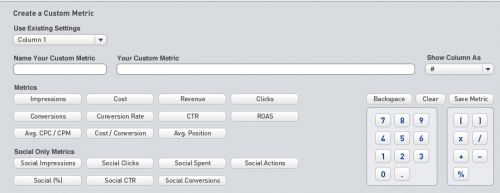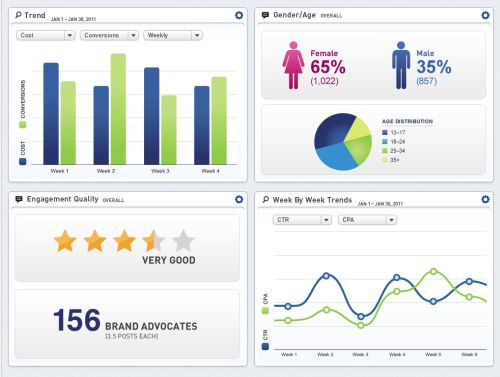Clickable’s Widget Dashboard: Expansion Into Cross-Channel Intelligence
Along with Google AdWords, it seems like the common denominator in every search marketer’s tool stack is Microsoft Excel. But for years, technology vendors in the search marketing industry have vowed to get us out of workbooks and have built workflow, analytics, and reporting tools aimed at doing just that. But no one’s really solved […]
Along with Google AdWords, it seems like the common denominator in every search marketer’s tool stack is Microsoft Excel. But for years, technology vendors in the search marketing industry have vowed to get us out of workbooks and have built workflow, analytics, and reporting tools aimed at doing just that.
But no one’s really solved it.
Some folks have come close. Most of the top-tier SEM platforms have very robust reporting tools—but the general consensus with search marketers is that they only go so far.
“Sure, the SEM tools sometimes do a great job solving for common problems. But when I have to do something fast, or even the least bit custom, or if I feel like I can re-use the tool again, I make it up in Excel and keep it around for future-use.” says search pro Crosby Grant, Director of Advertising Services with Stone Temple Consulting.
At the core of the issue is that most search marketers would love to not have all of the extra steps involved with importing SEM data into Excel and then having to pivot and filter it before even being able to start the analysis. If a tool can go 80% or even 90% of the way, that’s great, but then it still means Excel is needed somewhere along the way so why not just do it all there?
“We want to put a bullet in pivot tables and Excel,” said Jordan Franklin, director of social strategy at Clickable. “There was a time when Excel was an efficiency tool for advertisers. Now, with the massive volume and diversity of data channels, marketers need more powerful and flexible tools to answer their burning questions.”
Clickable’s plan to deliver reporting and intelligence across many channels starts with its Widget Dashboard (now available in beta).
Part of Clickable’s third-generation technology platform, the Widget Dashboard visually captures and displays all search and social marketing data.
The Dashboard gives digital marketers and agencies an easy-to-use platform for tracking and modifying campaigns across Facebook, Google and Bing. Already connected to Clickable’s ad management tool, it also enables future data integration of additional channels across social, search and video, as well as proprietary customer data sources. Upcoming integrations include LinkedIn, Twitter and Foursquare.
Their vision is to empower marketers and agencies to demonstrate ROI and improve decision-making through visually persuasive dashboards and intelligence that spans online and even offline channels.
Not only search and social, but display, YouTube, television ratings data, and even customer CRM — providing a holistic view of the entire marketing funnel, from branding, engagement, direct response and ongoing customer engagement.
Other companies do have similar dashboards, but Clickable’s plan doesn’t stop there. They know that once all of the marketer’s data in in one place, the next evolution of the tool will begin to deliver new business intelligence not only for search marketers, but for all key stakeholders in the marketing value chain — from account executives to digital strategists to chief marketing officers.
“The ability to leverage big marketing data has created opportunities to build tools and platforms that can surface insights around demand, supply, consumer behavior, segmentation, positioning and targeting,” said Max Kalehoff, vice president of marketing.
Let’s take a look at some screenshots from the current Widget Dashboard beta as well as some soon to be released features. Even though this is just the first step in Clickable’s plan for the tool, it still has some very strong functions that marketers are already leveraging for their campaigns.
As the tool’s name suggests, the dashboard is based on widgets which are the building blocks of the visualization features. You can build them from any metrics and then manipulate them into different configurations based on the types of reports you want to see.
As you can see below, widgets can mix data tables and charts/graphs to build out any combinations that you would want to see.
Want metrics? No problem. Any fields from data coming into the system can be chosen in the widget building process.
You can make your own custom metrics as well from any combination of data fields in the system.
For example, you could create a new column called “Total Cost with Fees” to include any markup from tool charges, agency fees, etc. This way ,you’re always looking at the right CPA and other revenue or cost related metrics.
On the bottom left, the Widget Dashboard is reporting on Clickable’s proprietary metric, Brand Advocates, which “defines people who like more than one post of a brand on Facebook, and either share or reply to at least on piece of content posted by that brand in a specific time period.”
Cool stuff! Right now, the tool is a very fast and intuitive dashboard that is competitive with the reporting features of other platforms on market.
However, Clickable maintains that this is in fact just step one to aggregate all of your cross-channel marketing data in one place. Once this has been accomplished, the idea is to bring in more outside data to bring context and deep business intelligence to the dashboard to make it a true SEM analyst’s dream tool.
Opinions expressed in this article are those of the guest author and not necessarily Search Engine Land. Staff authors are listed here.
Related stories
New on Search Engine Land




